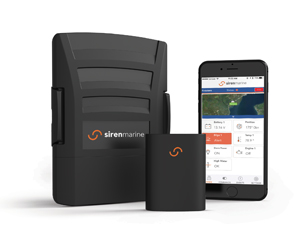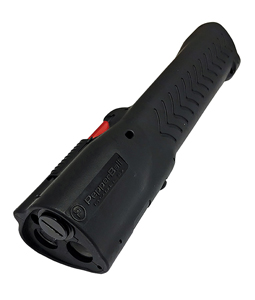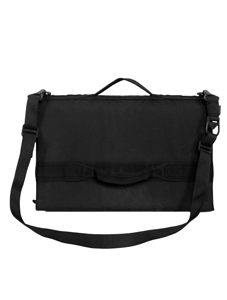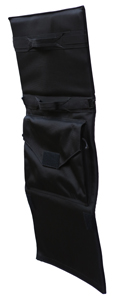It was a calm night in an isolated anchorage on the north coast of Papua New Guinea. Our friends had come aboard Oddly Enough for an evening of dinner, beer and making sailing plans, and they had dinghied off an hour prior to get some sleep. Now they were calling across the short distance between our boats.
“Oddly Enough, we’ve been robbed!”
I started out of bed so fast I hit my forehead on the underside of the deck and followed Tom to the companionway where both of us struggled to get out at once. Our friends were leaning across their gunwale and making hand signals to call them on the VHF. We did, and what they told us altered the night and the rest of our stay in Papua.
It’s not an unusual story for anyone who’s gone long-distance cruising, and that’s the point. Robbery and threats to person can be faced at home on land or on the water too, but in international waters we feel more vulnerable. Our strangeness combined with dependence on local communities adds to our vulnerability.
On the night in question, we were unprepared. Well, not entirely — we were the only boats in the bay and had tried to anchor out far enough from shore to avoid unwelcome visitors, but every night canoes passed on their way to and from fishing and softly hallooed us.
With the cat out of the bag, we closed ranks, inventoried our mutual weapon supply and set up two-hour watches for the nights we’d be anchored off the town. The town spread over a steep hillside and wrapped around the bay, and we were informed by residents that they could see us, lit up by cockpit lamps and surrounded by our machetes, spearguns and flare guns. Of course, that was the idea.
A better way?
But was there a better way to defend ourselves than to simply repurpose items already on our boats? The only thing in that arsenal I felt equipped to use competently was my speargun.
Since this article is intended to discuss non-lethal weapons, I won’t talk about handguns or shotguns and their drawbacks since these are often digested over cruising dinner tables. “Non-lethal weapons,” or NWLs, are what the U.S. Department of Defense says “deliver discriminate and reversible effects without causing unnecessary destruction or loss of life.” Non-lethal self-defense weapons are NWLs intended for personal protection, and virtually all states and countries have laws regarding their possession and use, especially those devices that push the limits of human injury like stun guns and Tasers.
Boaters need to protect themselves in three general ways: First is to repel boarders; second is to protect against thievery on the boat; and third is personal protection on land. The first two blend together, as illustrated by my opening story. Given the technology that’s out there, what could our friends have done to arrange a better outcome? Following are a few products that boaters should consider as game changers. They are representative of types of devices and are not necessarily the only or best in their field.
In examining our friends’ robbery, the first observation is that they lost the element of surprise. By the time they woke up, the boarders were already in the cockpit.
 |
|
Vessel alarm systems, like the Siren Marine MTC unit, can help with perimeter security and entry alarms. |
|
Courtesy Siren Marine |
Perimeter security
Perimeter security has come a long way since Joshua Slocum spread tacks on Spray’s deck to discourage boarders. To my mind, the use of apps — which first really hit the boating products market for the Miami Boat Show of 2018 — has made possible a giant leap in security for boats just as it has for houses.
Apps are based on the use of a smartphone (or tablet) as the communicator in an “Internet of things” network of objects that talk to each other. Siren Marine’s (sirenmarine.com) Connected Boat network starts with the MTC (“monitor, track, control”) Device, which pairs with sensors and an app. The sensors are tiny devices that measure changes in the environment using an electrical field. The data they measure is sent to the MTC Device, which processes and sends it to the app provided by Siren and installed by the user, which is where the user can select how to view the data and what to do next.
Sensors themselves have been around a long time; the metal-oxide-semiconductor (MOS) technology used in this kind of system is 50 years old. Aqualarm represents an older system for boats that includes a computing unit with sensors and an optional communicator that will dial two cellphone numbers and sends two emails when a security breach is detected. Both Aqualarm and the Siren MTC can communicate with other cellphones. It must be kept in mind that a system that uses an app, like Siren’s, only requires Bluetooth and not cellular service to function, whereas the Aqualarm has to be in reach of a cellular network. Aqualarm also depends on motion sensors; Siren offers motion sensors too, but as we know there are lots of things that move on or around a boat that are not intruders.
This brings me to Siren’s other intriguing product: a canvas snap sensor that replaces a snap in a boat cover. The cover could be anything from a dodger to a bimini to a side panel. When unsnapped, the embedded sensor signals the app that a change has been made, and the app then sends the user an alert.
The MTC system can also include sensors that offer bilge and battery alarms and GPS/geofencing for off-boat security. Hopefully a perimeter alarm would have woken our friends (and us, if we’d set up a buddy system through the app). This would have given them the chance to discourage intruders before they even boarded. Noise can be one of the most effective agents, and it can be generated by an alarm built into a system like the MTC or by humans using air horns or whistles.
 |
|
The LifeLite unit from PepperBall is both a flashlight and a pepperball launcher. |
|
Courtesy PepperBall |
Pepper irritants
If determined intruders get past the noise barrier, then the situation calls for a more serious deterrent. Borrowing from the general world of self-defense, we get pepper sprays: a general term for spray canisters that eject a chemical compound made from pepper that irritates eyes and can lead to temporary blindness. Pepper sprays have made it into purses and backpacks everywhere and are generally considered legal.
PepperBall has advanced pepper technology with LifeLite (pblifelite.com), a “launcher” designed to fire projectiles filled with pepper from 60 feet away — a significant improvement on the sprays that need to be used at close range. Its plastic projectiles burst on impact, spreading a 12-foot cloud of pepper powder. Although the LifeLite — which looks and acts like a large flashlight until the trigger mechanism is activated — has a laser sight that helps with aim, the balls can hit the ground in front of your target and still be effective.
As a longtime cruiser, I’m concerned about moisture getting into equipment that is not used often and rendering it inoperable just when it’s needed. PepperBall told me that LifeLite is water resistant but not waterproof, while the PepperBall projectiles are waterproof. Reviewers generally like it but comment that its large size makes it difficult for people with smaller hands to use. The device requires 12-gram CO2 cartridges to fire, which are not the same size as the cartridges designed for inflatable life vests.
One of the top-ranked, non-lethal, self-defense weapons recommended for general use is something called a tactical flashlight. Once defined as a flashlight used in conjunction with a firearm, tactical flashlights are considered an effective deterrent on their own with the advent of LED bulb technology. Instead of the usual 10 or so feet for which a household flashlight may be blindingly bright, a tactical flashlight can be effective at 100 feet or more and produce a powerful strobe that disorients potential attackers and hopefully either convinces them to take off or tips the advantage toward the boater.
Since the PepperBall launcher is not particularly grip-friendly for those of us with smaller hands, I personally would choose to pair it with a compact tactical flashlight for my boat. The Fenix PD35 TAC (www.fenix-store.com) has a powerful output of 1,000 lumens up to 656 feet, measures only 5.4 inches long, weighs 3.1 ounces and is waterproof up to 6.5 feet for 30 minutes. Like the LifeLite, it takes either a rechargeable battery or two disposable lithium CR123A batteries. Like all tactical flashlights, it is resistant to water, shock and corrosion, and it is made of aircraft-grade aluminum. The PD35 does not come with a wall mount, which would be useful on a boat, though it has other mounts that could be adapted.
 |
 |
|
The Multi-Threat Shield from Force Training is a defensive device that will stop handgun bullets and shotgun rounds. |
|
|
Courtesy Force Training Institute |
|
Personal shield
Finally, in the event an intruder makes it on board and effectively holes up the occupants, is there an option to simply wait out the situation? Our friends were locked in the forward cabin and kept there by someone with a gun. The gun, in fact, was a fake — just a length of steel pipe — but they didn’t know that at the time. Had they been so inclined as to try to break out, another new spillover from law enforcement is the bulletproof Multi-Threat Shield (multithreatshield.com) that can be opened from its discreet laptop bag-style package. It’s lightweight and unobtrusive, it doesn’t look offensive, it’s waterproof and it measures 3 feet by 17.5 inches when opened, which is sufficient to protect two people. It protects against attacks from knives and blunt objects. This would be useful only if the occupants had time to devise a plan for after they challenged the intruders from behind the shield, but if money is no object in putting together a boat inventory, the Multi-Threat Shield could be the space blanket equivalent for self-defense.
Substituting purpose-made self-defense weapons for repurposed boat items is expensive. The Siren Marine MTC Device retails for $599, it comes with the app and is the foundation for designing a Siren Connected Boat system. The wired Canvas Snap Sensor is priced at $29, which to me is one of its selling points (four of these equal the price of one Siren Beam Motion Sensor or Wireless Entry Sensor), as you could purchase a bundle and place them strategically. PepperBall’s LifeLite kit, which costs $229, includes five live projectiles, 10 practice projectiles, three CO2 cartridges and two disposable batteries. The Fenix PD35 TAC is $71.95 when purchased directly from Fenix. A Multi-Threat Shield is $1,250, which for me makes it the least attractive of these items to purchase ready-made; an enterprising boater could buy Kevlar cloth and denier ballistic nylon to make a shield that doesn’t open up from a case, which is a good feature for carrying in public but not necessarily on a boat. Ultimately, each boater has to decide what it’s worth to be protected.
Ann Hoffner is a freelance writer who, with her husband, photographer Tom Bailey, spent 10 years living and traveling on S/V Oddly Enough, a Peterson 44.

